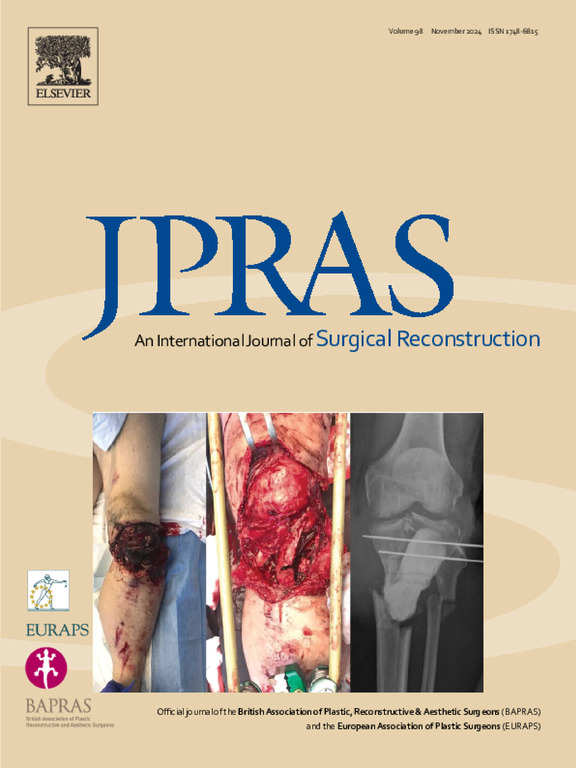Free fillet flap: Outcomes in emergency microsurgical reconstruction of upper and lower limb
IF 2
3区 医学
Q2 SURGERY
Journal of Plastic Reconstructive and Aesthetic Surgery
Pub Date : 2024-10-16
DOI:10.1016/j.bjps.2024.10.018
引用次数: 0
Abstract
Introduction
Despite its infrequency, ‘spare-part surgery’ represents a reconstructive strategy that uses segments of amputated limbs as donor tissue to preserve function in other injured anatomical regions. The purpose of this study was to review our 14-year experience in emergency microsurgical reconstruction of traumatised limbs using free fillet flaps obtained from non-salvageable amputated parts.
Materials and methods
A retrospective observational study was conducted on patients who underwent urgent free fillet flap transfer for upper or lower limb reconstruction between 2007 and 2021. The characteristics and levels of injury, as well as the flap designs, functional outcomes and complications were documented.
Results
A series of eight clinical cases is presented. One osteo-tendino-cutaneous and seven fasciocutaneous flaps were filleted from non-replantable amputated limbs for free transfer. Stable coverage of the dorsal aspect of the hand and fingers was achieved in three patients, and limb shortening was avoided in five patients. An open thumb fracture with bone defect, three below-knee stumps and one trans-metatarsal level were preserved. The mean Quick-Disabilities of the Arm, Shoulder and Hand score for upper limb reconstructions was 16.75 points. In all the cases of lower limb reconstruction, the nerves were repaired, resulting in a protective sensitivity (S3 level) with no pressure ulcer development during the follow-up period. All patients were able to return to normal prosthetic ambulation with a mean Amputee Mobility Predictor Pro score of 45 points. Two haematomas, one surgical wound dehiscence and two immediate revisions of venous anastomoses were registered.
Conclusions
The microvascular filleted flap demonstrated versatility in the emergency reconstruction of complex limb injuries, providing stable coverage and optimising limb length preservation within a single major surgical procedure, while eliminating morbidity from any other uninjured donor site.
游离丝状皮瓣:上下肢急诊显微外科重建术的成果。
导言:备肢手术 "尽管并不常见,但它是一种利用截肢部位作为供体组织来保留其他受伤解剖区域功能的重建策略。本研究的目的是回顾我们 14 年来利用从不可修复的截肢部位获取的游离丝状皮瓣对创伤肢体进行紧急显微外科重建的经验:我们对2007年至2021年期间紧急接受游离丝状皮瓣转移进行上肢或下肢重建的患者进行了回顾性观察研究。研究记录了患者的特征、损伤程度、皮瓣设计、功能结果和并发症:结果:本文介绍了八例临床病例。其中一个骨腱皮瓣和七个筋膜皮瓣是从不可再植的截肢上锉下来的,用于游离转移。三名患者的手背和手指得到了稳定的覆盖,五名患者避免了肢体缩短。保留了一个开放性拇指骨折伴骨缺损、三个膝下残肢和一个跨跖骨水平。上肢重建的手臂、肩部和手部快速残疾评分平均为 16.75 分。在所有下肢重建的病例中,神经都得到了修复,从而获得了保护性灵敏度(S3 级),并且在随访期间没有出现压疮。所有患者都能恢复正常的假肢行走,截肢者活动能力预测器 Pro 平均得分 45 分。有2例血肿、1例手术伤口开裂和2例静脉吻合术后立即复位:微血管丝状皮瓣在复杂肢体损伤的紧急重建中表现出了多功能性,在单次大手术过程中提供了稳定的覆盖,优化了肢体长度的保留,同时消除了其他未受伤供体部位的发病率。
本文章由计算机程序翻译,如有差异,请以英文原文为准。
求助全文
约1分钟内获得全文
求助全文
来源期刊
CiteScore
3.10
自引率
11.10%
发文量
578
审稿时长
3.5 months
期刊介绍:
JPRAS An International Journal of Surgical Reconstruction is one of the world''s leading international journals, covering all the reconstructive and aesthetic aspects of plastic surgery.
The journal presents the latest surgical procedures with audit and outcome studies of new and established techniques in plastic surgery including: cleft lip and palate and other heads and neck surgery, hand surgery, lower limb trauma, burns, skin cancer, breast surgery and aesthetic surgery.

 求助内容:
求助内容: 应助结果提醒方式:
应助结果提醒方式:


